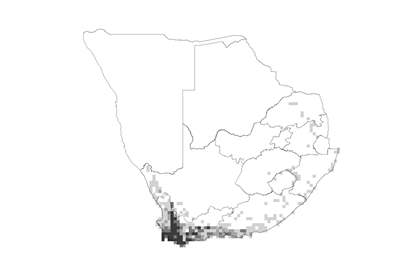 Species distribution and density. Darker squares represent higher density of members of this family. |
Introduction
Cape reed family
Restionaceae is one of the families that characterises the Fynbos Biome and here it largely occupies the position grasses maintain in other biomes. In South Africa it has been a sought-after building material that has been put to multiple uses, from building basic shelters in the veld, to thatching the famous Cape Dutch houses dating back to the 17th century.
Distribution
A southern hemisphere family, with most species in southwestern South Africa and western Australia. Also occurs in Chile, Madagascar, New Zealand and Malaysia.
Number of genera in the world
ca. 55
Number of species in the world
ca. 490
Number of genera in the Flora of southern Africa region
18
Number of species in the Flora of southern Africa region
299
Well-known southern African genera
Cannomois, Chondropetalum, Elegia, Hypodiscus, Restio, Rhodocoma, Thamnochortus, Willdenowia
Growth forms
Rush-like, tufted, rhizomatous or stoloniferous.
Habitats
Found in marshes, swamps, seasonally dry, fire-prone habitats, from sea level to altitudes of up to 2 500 m.
Flagship species
Cannomois virgata (bellreed; bergbamboes, besemriet [A]) is a truly magnificent example of one of the large restio species, which can become bamboo-like and reaches up to 3 m in height. It is quite widespread in the Western and Eastern Cape where it is common on moist mountain slopes and along streams. Inflorescences of male plants can be up to 0.5 m long with hundreds of small spikelets clustered on branchlets at the nodes. Female plants have fat spindle-shaped spikelets, each bearing several large black fruits.
Significance of the family
A number of species are extensively used for thatching. Today the main species used is Thamnochortus insignis, which is harvested and even cultivated in the Albertinia area of the Western Cape. It is used in thematic or waterwise gardens and has become a signature/feature plant in flower beds or potted gardens. The horticultural importance of various restio species is continuously being explored and more and more species are becoming available in the trade.
Diagnostic characters
Grass- or rush-like ; plants usually dioecious (separate male and female plants). Stems mostly solid and circular in cross section . Leaves mostly reduced to sheaths in older plants ; culms with abscission rings where sheaths have dropped off ; sheaths split down to the base . Inflorescences at the tip of culms . Flowers included in spikelets , occasionally with conspicuous spathes. Fruit a capsule or a nut .
Did you know?
Roofs thatched with high quality restios can last for up to 50 years before they need to be redone.